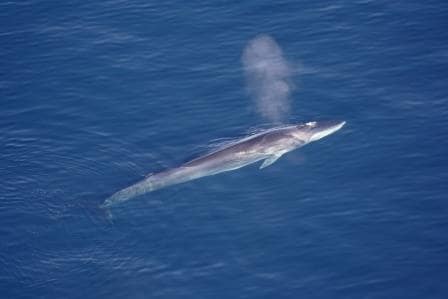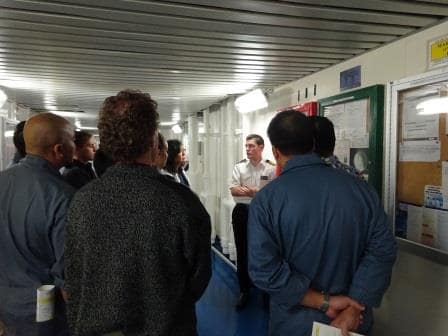During the night the Mistral in the Rhone area thought the better of it and decided to abate completely so this morning we only had a long running swell left and a flat calm sea. As the Zuiderdam was happily pottering long with a speed of 11 knots it did not even make the ship move. It was full on the bow and thus it could have created a pitching movement but we hit the waves so gently that there was no wobbling whatsoever. Also for the remainder of the day it looks like that the wind has gone completely. During the late afternoon and early evening we will sail just south of the Gulf of Lyon and if the Mistral would have been still there, large waves would have coming rolling out of it. But we are lucky today.

I would love to take credit for this photo but the few times I have seen a Fin whale this close, there was no camera handy. (Photo Courtesy: Wikipedia)
Some guests were lucky today as well, as we had a number of Fin whales coming by. The bridge counted 5 or 6 of them but I only saw one and that was much later. Still seeing a Fin whale in the Mediterranean Sea is not as usual as seeing Humpbacks in Alaska and seeing 5 or 6 together is quite rare. The navigators and quartermasters easily recognize the various whales as we are all trained in doing so. Holland America stipulates that each person who keeps a look-out on the navigation bridge is proficient in recognizing the various sorts of whales. If we recognize them, then we also know what sort of behavior to expect and that helps to make a more quantified decision in how to avoid them. Fin whales we can recognize in two ways: looking for the small dorsal fin near is tail or by the exhaust plume (expelled air) which has a very distinctive shape.
In this case the whales happily swam along on either side of the ship and thus no course changes were needed. When we are near whales we are also advised to slow down to 10/11 knots to reduce the chance of a collision even further but as we were already doing that speed, we were in compliance without having to take any action. The whales did not take any action either to make our life difficult and thus everybody was happy.
Although we are sailing between the Island of Corsica and the Italian main island, the sea is still quite deep here, up to 9300 ft. in the North Western part and that would make Corsica a very high hill if we could pump the Mediterranean Sea empty. But the sea is full and Corsica is a big mountain top called an Island, right between Livorno and Barcelona.

Safety Indoctrination by Matt the 2nd officer for the new HAL employees. In the audience, the ships doctor, the piano player, photographer, beautician, sailors and fireman greasers.
One of the things, which I am exposed to every time I change ships is the Shipboard Orientation Program. Everybody has to attend it, from the captain downwards and thus I happily show up each time and watch the proceedings. There are two parts: 1. when coming on board, before you allowed even to start to work you need to get familiarized with the basic safety concepts of the ship and your safety duties while on board. Then there is a second more in depth part on the 2nd or 3rd day, depending when is best as long as it is within 72 hours of boarding. Captain and Ships Staff, introduce themselves and speak some wise words, the ships nurse tells us where to find the hospital and how to stay healthy and the Security Officer tells us to be alert and wear our I.D’s at all times. Then there is a session with the Safety and Environmental Health officer, who touches on all the basic concepts we have to follow. Then the crew who are not new, or have sailed on the same class of ship in the last 3 years are dismissed and can go back to work.
The rest have to stay for a walk about to get some explanation about watertight doors, fire extinguishers, station bills and everything that might just be different from what they were used to before, or what is completely new to them. I normally trundle along with this group as it gives me the chance to observe the quality of training being given by the Training Officer. He did a very good job and the audience remained alert. Thus all went well today and one hour later the whole group was dismissed.
Tomorrow we are in Barcelona, where we stay until late in the evening. We will not be the only one; The Marina, the Costa Fascinosa and the Berlin are also expected. Weather sunny with temperatures in the mid 60’s or 18 to 19oC. Perfect day for sightseeing.

October 23, 2015 at 5:31 pm
Please Captain Albert, what are “fireman greasers” ?
Thanx….Ruud
October 24, 2015 at 2:53 am
Good morning,
Thank you for still reading my blog. Fireman Greasers are what quartermasters are for the deck department.
They run a watch in the ER and help the engineers on duty to ensure a smooth running. Checking engines, doing tank soundings, monitoring local systems etc.etc. Then there are also Wipers, these are comparable to sailors. they do the maintenance in the engine spaces. Painting, helping with overhauls, cleaning, supplies etc etc.
Best regards
Capt. Albert